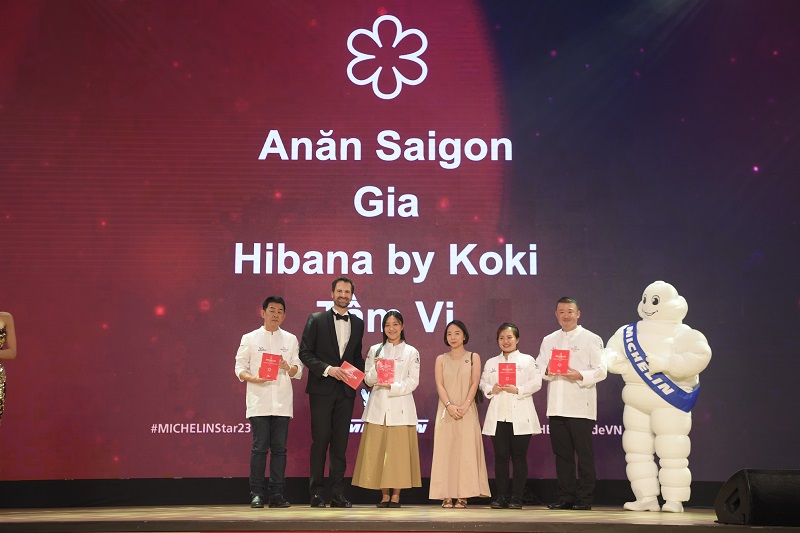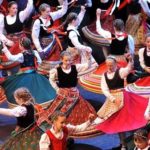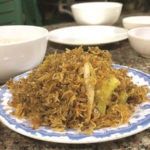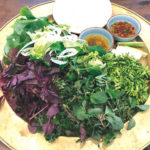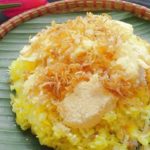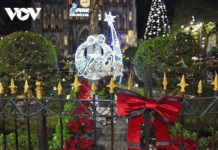Over the past few years, Vietnamese cuisine has garnered much praise from major travel websites and food guides, indicating its potential as a popular tourist attraction. To fully tap into this potential, it is crucial for the tourism industry to create a local food map.
Many advantages for captivating travelers
| Four Vietnamese restaurants have recently been awarded Michelin stars.Photo: Michelin Vietnam |
On June 6, the world-renowned Michelin Guide awarded one star each to four Vietnamese restaurants, three of which are located in the capital city of Hanoi.
Prior to this, Hanoi was voted as one of the top 20 food destinations in the world for 2023 by readers of TripAdvisor, the largest travel site. Additionally, Vietnam was named the best culinary destination in Asia in 2023 by the US travel website Travel + Leisure.
Hanoi’s cuisine has impressed not only tourists but also international politicians. Former US President Barack Obama enjoyed bun cha (Vietnamese grilled pork with rice noodles) in Hanoi in 2016, and former South Korean President Moon Jae-in and his wife savored beef noodle soup in the same city in 2018.
Australian Prime Minister Anthony Albanese surprised locals when he visited a steam beer bar on Duong Thanh Street in Hanoi and sampled local specialties.
| Fresh noodle with duck, a Hanoi specialty prepared by Tam Vi’s chef |
Nguyen Trung Khanh, General Director of the Vietnam National Administration of Tourism, believes that the four Michelin-starred restaurants will enhance Vietnam’s food tourism brand and attract international tourists to choose the country as their next destination.
“The fact that Vietnam’s cuisine in general, and Hanoi’s in particular, has received stars from the Michelin Guide and has been selected by TripAdvisor as one of the world’s top culinary destinations in 2023, shows that Vietnamese cuisine is gradually gaining recognition on the world’s food map. This is a great potential to attract international visitors,” Nguyen said.
“In the coming period, the tourism industry will continue to promote Vietnamese cuisine worldwide through international fairs, with a focus on Michelin Guide-starred restaurants and hotels. We will also strengthen cooperation between travel agencies and these restaurants in organizing food tours,” he added.
According to Nguyen Quoc Ky, Chairman of the Vietnam Culinary Culture Association, Vietnam’s unique and diverse cuisine can create many attractive tourism products to enhance the experience and encourage tourists to stay longer.
A master plan needed
| The dish of polemo salad is prepared by chefs from Sente Restaurant in Hanoi |
The World Food Travel Association (WFTA) estimates that international tourists spend 25-35% of their travel budget on food and beverages. To tap into this “gold mine,” it is vital for the tourism industry to create a food map that attracts travelers.
Phung Quang Thang, chairman of the Hanoi Travel Association, stated that although many travel companies have offered food tours in Hanoi, these tours have not made a significant impact yet. For a successful themed food tour in Hanoi, two factors must be identified: highlighted dishes for promotion, and the development of professional restaurants specializing in Vietnamese cuisine.
“Visitors come on a food tour not only to eat but also to explore and participate in the preparation of food and experience the Hanoian taste,” Thang explained.
Nguyen Cong Hoan, CEO of Flamingo RedTours, pointed out that culinary tourism is a highly cultural and artistic service.
| A variety of Hanoi specialties like cha ruoi (sandworm omelet), cha com (young sticky rice sausage) or spring rolls are always available at the restaurant of Luklak Vietnamese Cuisine |
“Therefore, Hanoi should have a master plan for the stable development of food tourism, encouraging both luxury restaurants and street food. Hanoi should also implement a policy for branding and developing internationally recognized restaurants, thus strengthening the position of Hanoi’s food and Vietnamese food in general,” he suggested.
To promote food tourism, Hanoi has opened specialized streets such as Tong Duy Tan Food Street in Hoan Kiem District and Dao Ngoc – Ngu Xa Night Food and Walking Street in Ba Dinh District, for tour operators to conduct food tours.
Building upon Hanoi’s Michelin-starred restaurants, Dang Huong Giang, director of the Hanoi Department of Tourism, stated that according to Hanoi’s tourism development direction for 2030, culinary products and services will be diversified.
| A new concept of gastronomy in Hanoi: the tasting menu is served at Gia Restaurant |
To make food tourism products a strength of Hanoi’s tourism, the Hanoi Department of Tourism will intensify the promotion of Michelin-starred restaurants and other prestigious diners and eateries through various media channels, social networking sites, and domestic and international tourism promotion events.
“We will create a food map so that tourists can discover and experience local cuisine,” Giang said.
Streetside service station serves up surprise
When you travel a long distance these days you stop by a service station to take a rest and get some food. The trick then was to spot where the trucks were to find good fresh at a reasonable price.

